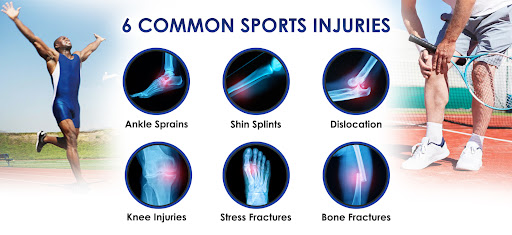What are Sports Injuries?
Sports injuries are physical injuries sustained during athletic activities, exercise, or participation in sports. These injuries can affect various parts of the body and vary in severity. They typically occur due to accidents, poor training practices, improper equipment, lack of conditioning, or insufficient warm-up and stretching.
What Are The Most Common Types Of Sports Injuries?
The most common types of sports injuries include:
Sprains:Ligaments are the bands of tissue that attach bones to one another, and they can be torn or stretched in certain situations. The ankle is the most common location for sprains.
Strains: These are wounds to the tissues that attach muscles to bones, called tendons or muscles. They frequently arise from overusing or overstretching a muscle.
Fractures: These are fractures in the skeleton. They may result from overuse, repetitive stress, or a direct hit or contact.
Dislocations: When the ends of your bones are pushed out of their natural placements, this happens. Fingers and shoulders are frequently affected.
Knee Injuries: These can range from minor ailments like ACL (anterior cruciate ligament) tears to more serious conditions like runner’s knee, which is discomfort around the kneecap.
Shin Splints: This word describes pain that runs along the tibia, or shin bone. Running and other repetitive stress on the lower leg are common causes.
Tendonitis: This is an inflammation of a tendon, usually affecting the knee, wrist, elbow, or shoulder (tennis elbow).
Concussions: These are a type of traumatic brain injury caused by a blow to the head or body that causes the brain to move rapidly within the skull.
What Treatments Are Available For Sports Injuries?
Treatment options for sports injuries vary depending on the type and severity of the injury. Common treatments include
Rest: Letting the wounded region heal and rest. For most sports injuries, this is the initial course of treatment.
Ice: Applying ice packs to reduce swelling and numb pain. Typically used for 20-minute intervals several times a day.
Compression: Applying elastic bandages or wraps to the wounded area will help to support it and reduce swelling.
Medications: Acetaminophen or ibuprofen, two over-the-counter pain medications, can help lessen discomfort and inflammation.
Immobilization: Employing braces, casts, or splints to stabilize the wounded area and stop more damage.
Heat Therapy: Applying heat to relax and loosen tissues and stimulate blood flow to the area. Often used in later stages of healing.
Surgery: Necessary for serious injuries such as fractures requiring realignment, damaged ligaments (such as ACL tears), or injuries that don’t improve with conservative care.
Corticosteroid Injections: Lowering pain and swelling when tendonitis or bursitis is severe.
Chiropractic Care: Manual adjustments and manipulations to relieve pain and improve function, especially for back and neck injuries.
Diagnosing sports injuries typically involves a combination of the following steps
How Are sports injuries diagnosed?
Diagnosing sports injuries typically involves a combination of the following steps
Physical Examination: A comprehensive physical examination will be performed to evaluate the injury. The affected area’s range of motion, discomfort, deformity, swelling, and bruises will all be examined by the healthcare professional.
Imaging Tests: X-rays, MRIs, or CT scans to assess the extent of the injury.
Functional Tests: Evaluations of the strength, stability, range of motion, and usefulness of the impacted area. This can involve particular movements to check the strength of muscles, tendons, and ligaments.
How To Prevent Sports Injuries?
Preventing sports injuries involves a combination of proper training, using appropriate equipment, and maintaining overall physical health. Here are some key strategies:
Warm-Up and Cool Down: To improve flexibility and enhance blood flow to the muscles, always begin with a decent warm-up. After working out, cool down to gradually lower your heart rate and loosen up muscles.
Use Proper Technique: To prevent putting undue strain on your body, learn and apply the proper skills for your sport.
Strength Training: Incorporate strength training activities to strengthen your muscles, which will support your joints and help keep you injury-free.
Flexibility Exercises: Regularly practice stretching and flexibility exercises to maintain a full range of motion in your joints.
Rest and Recovery: Take enough time off in between workouts and contests to avoid overuse injuries. Make sure you obtain adequate rest to aid in your recuperation.
When Should To See a Doctor for a Sports Injury?
You should see a doctor for a sports injury if you experience any of the following:
Severe Pain: Severe pain that is not alleviated by rest, ice, or over-the-counter analgesics.
Swelling: Significant swelling that either doesn’t go away or becomes worse over a few days.
Inability to Bear Weight: Having discomfort or weakness in the affected limb that makes it difficult to use, walk, or stand.
Numbness or Tingling: Sensory loss or tingling in the afflicted location, which may be a sign of nerve injury.
How Long Does it Take To Recover From a Sports Injury?
The length of time it takes to recover from a sports injury varies greatly based on the kind and extent of the injury, the patient’s general health, and how well they follow the recommended treatment plan. Here are a few broad recommendations:
Minor Injuries: A few days to a few weeks.
Moderate Injuries: Several weeks to a few months.
Severe Injuries: Several months to a year or more.


